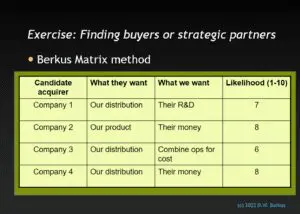Get organized.
Finding your strategic partner, investor or business buyer is not something you do haphazardly. There are many steps to take, each closer to assuring a success. Research is paramount, and sources are everywhere, especially for public companies and large investment firms.
Start with the “matrix method.”
You and your advisors, board or partners should start by completing what you can of the matrix shown on this page. It will help you to focus upon the most likely candidates and save lots of time. Here are the steps to take.
matrix shown on this page. It will help you to focus upon the most likely candidates and save lots of time. Here are the steps to take.
Find up to ten likely candidates that fit your business.
You can list companies you know, have contacts within, or that fit your industry segment. Think of those who might need what you have to offer. In fact, that leads to the most important part of this process.
Examine the four columns in the matrix.
[Email readers, continue here.] Column one is your list of your candidates in no particular order, usually the result of a brainstorming session where you participate or lead. For corporate boards, even those not looking for a buyer at this time, I often help to manage this exercise in board meetings once every few years. It keeps the board and CEO focused upon an ultimate exit. That’s important when you’ve taken money from investors and have outside shareholders. When taking their money, you made a promise to “make them liquid” someday, not to build a lifestyle business where they would be trapped forever, unable to see a return on their investment.
Column two is the golden ticket.
“What would the candidate want from your company in a transaction?” Think carefully. Some potential buyers or strategic partners might want your intellectual property, or revenues, or profitability, geographic advantage, or sale force, or your employee base. Select the most likely reason you’d find if you could “get into their heads” and see what they might value most. We’ll come back to this column in a moment.
Column three is important for you and your stakeholders.
Here you state in a few words what your company would want for the candidate – other than cash or investment which seems obvious. Your definition of a great fit might include their distribution capability, their brand, dominance in your field, their sales force, their access to growth capital or more.
Column four is the easiest but also important.
Here, on a scale of 10 to 1, is your best guess of the likelihood of making a favorable deal with the candidate. A 10 means that you are absolutely sure there is a need and a fit and the ability of the candidate to pay in a range you anticipate. A 1 is tantamount to a complete waste of time.
Now return to column two.
You will surely notice that a majority of your estimates of the candidate’s interest or needs are the same, one to another. This may surprise you and the team because this is your (sometimes hidden) core competency as others see you. A wise board and management would take their own hint and strengthen that core, whether it is your development team, your geographic dominance or other trait. And strengthen that at the expense of other areas of your enterprise which may easily be outsourced or reduced in scope.
The net result of this exercise.
You will have focused upon your real value, identified a list of companies with executives you need to know soon, even if long before any suggestion of a transaction. Even a five-minute introductory call to the CEO with no agenda works for later name recognition. And the exercise of researching through search engines, friends, financial sites or trade publications will begin to help you develop a picture of each candidate’s needs and strengths.
This exercise is time well spent and should pay back in multiple ways in your future if not immediately.









Great article as usual particularly in the structure and simplicity. Thx for sharing.
david